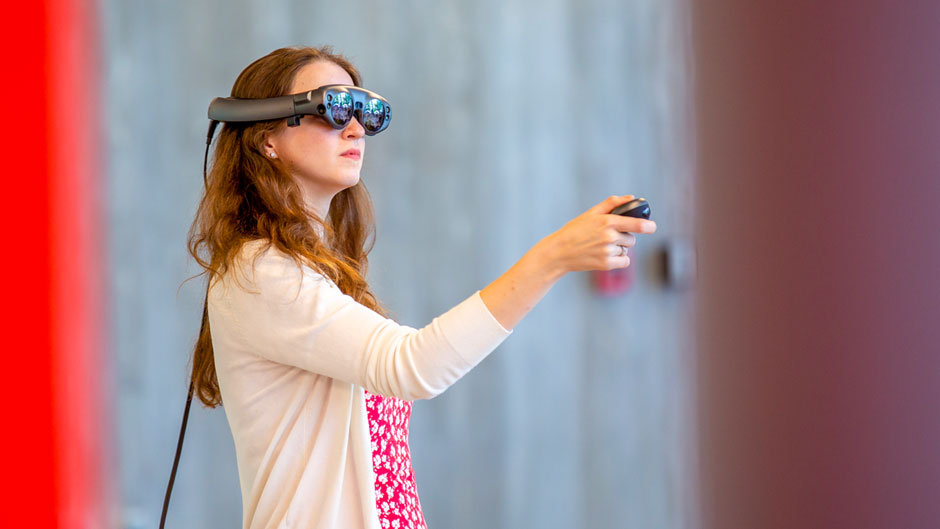Hunched over a project in her workspace, the student’s desk suddenly turns bright red, reminding her it’s time to move. Today, she decides, she has time for yoga and, after depressing the hand-held trigger to her headset, a pint-sized yoga instructor appears on her desk and begins bending and twisting.
But the clutter and bustle inside the School of Architecture’s Thomas P. Murphy Design Studio Building isn’t exactly conducive to meditative exercise, so with another pull on the trigger, the student surrounds herself with a lush, sun-dappled forest.
Her mixed reality isn’t the stuff of dreams, but rather a window into the future imagined by architecture students in the first University of Miami course designed to explore the potential of Magic Leap’s new spatial computing platform for bridging the physical and virtual worlds—and transforming the University into what the South Florida-based company calls the Magicverse.
“It’s awesome,” said Jeffrey Duerk, executive vice president for academic affairs and provost, who dropped by the class’ juried final review on Wednesday. “This is why we are so excited to have the relationship and opportunity with Magic Leap. This technology is going to be applicable everywhere. It’s really amazing.”
Last fall, just months after Magic Leap unveiled its highly anticipated mixed reality glasses, founder and UM alumnus Rony Abovitz announced a unique educational alliance with his alma mater: The tech company pledged to put the headsets that move computing from the 2-D screen into our 3-D world into the hands of students, turning the University into a laboratory for testing ideas and prototypes for the incalculable, transformative uses of spatial computing.
A pioneer in embedding technology in our built environment, architecture Dean Rodolphe el-Khoury jumped at the chance to have his students explore the synergies between that embedded technology, known as the Internet of Things, and the new reality that Magic Leap’s seemingly magic glasses enable—one where digital images can be projected anywhere in our physical environment.
“These students had to learn everything from scratch so it was an incredible learning curve,” el-Khoury said during a break in Wednesday’s demonstrations. “But they succeeded with the ambition of their ideas and the technical knowledge and skills required for these demonstrations.”
In all, four teams, each comprised of three students, demonstrated how spatial computing could open new possibilities in architectural design in one of four realms: Learning, Health and Well-Being, Social and Entertainment, and Productivity. Donning the headsets, a panel of judges drawn from Magic Leap and the architecture faculty, experienced and critiqued each project.
The yoga instructor was a member of the Health and Well-Being team, at least virtually. For their project students Yasmine Benchekroun, Fioriana Larche, and Yibo Zhang infused the Murphy Design Studio with ambient senses that could nudge its occupants into healthier living. Walk past a water foundation and it blooms with a subtle light that entices passersby to drink, and then cracks as if made of parched clay—a warning that you are dehydrated. Enter the café, and see how many steps you’ve taken that day, what your heart rate is, and other clues to your well being.
The Learning team’s Alex Underwood, Jose Mozza Vargas, and Fuhong Wang transformed the School of Architecture library into a learning-by-doing portal of knowledge. Upon entering, visitors could browse the stacks of any library, pull any book off the shelf, and copy and share any of its pages. But that’s not all. If they wanted to tour Swiss-French architect Le Corbusier’s modernist masterpiece, Villa Sayoye, no problem. Just lift it off the page, put it on the table, let it float in the air, and examine it from every angle. Even cut it in half, if you’d like.
That experience delighted architecture professor Sonia Chao, who broke into a huge smile as her Magic Leap headset projected an image over her head she never imagined she could see: the bottom of the renowned country retreat Le Corbusier built outside of Paris.
“What an exciting and rich teaching experience,” Chao said. “It really allows students to understand how a building is assembled. This has so many applications, in academia and in practice.”
Her fellow instructor, Germane Barnes, who served on the jury that critiqued the projects, foresaw another advantage, at least for professors: Students will lose a favorite excuse: “The first thing they tell us is, ‘Well, they didn’t have the book I was looking for.’’’
The Social and Entertainment team took their realm in a slightly different direction, with members Xiangyu “Jack” Shao, Ashley Zambrano, and Jiayi Wang exploring ways to personalize each student’s workspace in the cavernous Murphy building. Through a system of “virtual zoning,’’ they divided the studio into public, semi-public, private, and semi-private layers, with each layer dictating what each person in the building would see.
Before entering, for example, Wang was greeted with a personalized banner that reminded her of her schedule for the day. If she allowed it, a visit to her desk would display the project she was working on, or the augmented decorations she created to make the space her own.
“Every semester we move around, so we were trying to give a sense of comfort and place,” Zambrano said.
Duerk arrived in time to experience the final presentation, which envisioned an expanded future for the oval Harkness table, which by its shape is designed to facilitate student-centered, discussion-based learning. But the Productivity team’s Saad Alhajri, Kyle Ferry, and Dylan Rzepka imagined a far-more interactive role for the table, which is a centerpiece of the University’s Quality Enhancement Plan.
In their future, students who are physically in different buildings across the University could not only gather at the same table and look each other in the eye, they could drop into discussions at any Harkness table anywhere around the world and do the same.
“This is so awesome,” the provost said, after removing his Magic Leap glasses and taking an old-fashioned selfie with the Productivity team.

